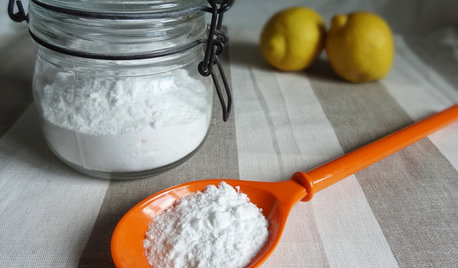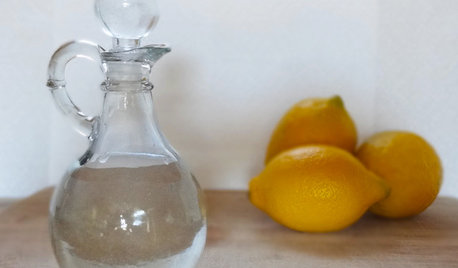Epsom salts
A local nursery owner told me she always puts a ring of Epsom salts around her tomato and pepper plants. Said it makes the stem very sturdy. My soil tests OK for magnesium and I assume by adding dolomitic limestone, I have been amending the garden with some magnesium.
Does anyone else add this extra to their tomato plants?
coriander
Comments (59)
allrawpaul
18 years agolast modified: 9 years agoHow long does it take for soil to return to normal after adding epsom salts? I added a tablespoon to each tomato hole along with a handfull of dolomite lime. I have acid silt soil, but I hope I didnt overdo it! Should have tested first, ugh! Paul.
dchall_san_antonio
18 years agolast modified: 9 years agoI consider Epsom salt to be a nonselective poison for soil fungi. Any ingredient that reads like this, blanketyblank SULFATE, I stay miles away from.
Related Professionals
Carson Landscape Architects & Landscape Designers · Eden Prairie Landscape Architects & Landscape Designers · Elwood Landscape Architects & Landscape Designers · Rancho Palos Verdes Landscape Architects & Landscape Designers · Cudahy Landscape Contractors · Northport Landscape Contractors · Ramsey Landscape Contractors · Siloam Springs Landscape Contractors · South Hackensack Landscape Contractors · Suitland Landscape Contractors · Twin Falls Landscape Contractors · Hawaiian Gardens Landscape Contractors · Cary Decks, Patios & Outdoor Enclosures · Salt Lake City Decks, Patios & Outdoor Enclosures · Acushnet Stone, Pavers & Concretekestie
18 years agolast modified: 9 years agoI use a tablespoon of Epsom salts on my peppers when the first bloom appears on the pepper. I have found that it adds the right amount of magnesium to make big blocky peppers that taste right. It was sucessful with both sweet and hot peppers. (California Wonder, Anaheim, and Hungarian Hot)
I was gardening on porceline clay soils that with limestone edgers, and I still got blossom end rot in my peppers. I asked the extention service why I needed it, and he said that even though it shouldn't be a problem, peppers need such a big rush of magnesium that the soil sometimes can't keep up, or the roots simply can't grab enough from the soil, no matter how correct the tests come back. Modern peppers are huge compaired to the original.
I got this idea from the magazine Organic Gardening, and then one of the farm catalouges came out with a side dressing schedule that I used to nudge my vegetables along, and it called for a side dressing for peppers at first bloom. Sure everyone laughed at me for giving my peppers a foot up, but it worked.
squeeze
18 years agolast modified: 9 years agoallrawpaul - not to worry - I've been adding epsom and dolomite to my tomato plantings in this acid PNW soil for years, and always have great crops
Bill
coriander
Original Author18 years agolast modified: 9 years agoGreat posts. I'l going with the positive ones on adding the additional magnesium and hope for the best. Let's remember to post some results in late summer on our tomato and pepper crops!
coriander
MonkeyGirl
18 years agolast modified: 9 years agoI should have thrown those old Tums into my compost pile!
KikibooCRZ
18 years agolast modified: 9 years agoDoes anyone have any recomendations about the application of epsom salts to peppers and tomatoes in containers. I did a soil test yesterday and found that my soils are high i all of the major nutrients NPand K. Any suggestions would be great. Thanx.
KiTermater
18 years agolast modified: 9 years agoThe History and Science of Epsom Salts
This natural mineral, discovered in the well water of Epsom, England, has been used for hundreds of years, not only to fertilize plants but to treat a range of human and animal ailments. Who hasn't soaked sore feet in it at least once? Chemically, Epsom salts is hydrated magnesium sulfate (about 10 percent magnesium and 13 percent sulfur). Magnesium is critical for seed germination and the production of chlorophyll, fruit, and nuts. Magnesium helps strengthen cell walls and improves plants' uptake of nitrogen, phosphorus, and sulfur.
Sulfur, a key element in plant growth, is critical to production of vitamins, amino acids (therefore protein), and enzymes. It's also the compound that gives vegetables such as broccoli and onions their flavors. Sulfur is seldom deficient in garden soils in North America because acid rain and commonly used animal manures contain sulfur, as do chemical fertilizers such as ammonium sulfate.
The causes and effects of magnesium deficiencies vary. Vegetables such as beans, peas, lettuce, and spinach can grow and produce good yields in soils with low magnesium levels, but plants such as tomatoes, peppers, and roses need high doses of magnesium for optimal growth. However, plants may not show the effects of magnesium deficiency until it's severe. Some common deficiency symptoms are yellowing of the leaves between the veins, leaf curling, stunted growth, and lack of sweetness in the fruit.
Magnesium tends to be lacking in old, weathered soils with low pH, notably in the Southeast and Pacific Northwest. Soils with a pH above 7 and soils high in calcium and potassium also generally have low magnesium levels. Calcium and potassium compete with magnesium for uptake by plant roots, and magnesium often loses. Sometimes, a soil test will show adequate magnesium levels in soil, but a plant grown in that soil may still be deficient because of that competition.
Gardeners add magnesium when they apply dolomitic lime to raise the soil's pH. However, this product (46 percent calcium carbonate, 38 percent magnesium carbonate) breaks down slowly, and the calcium can interfere with magnesium uptake. For soils with a pH above 7, many gardeners use Sul-Po-Mag (22 percent sulfur, 22 percent potassium, 11 percent magnesium) to increase magnesium. Although dolomitic lime and Sul-Po-Mag are inexpensive ways to add magnesium, Epsom salts' advantage over them is its high solubility.
When diluted with water, and especially when applied as a foliar spray, Epsom salts can be taken up quickly by plants. Epsom salts' magnesium content, high solubility, and ease of application as a foliar spray are the main reasons for the positive results many gardeners see in their plants.
Apply 1 tablespoon of Epsom salts mixed with a gallon of water as a foliar spray to plants at bloom time and again 10 days later.
Before you try Epsom salts, test the soil to determine its magnesium content. Don't rely on Epsom salts to correct large soil magnesium deficiencies, but rather use it as a supplement to soils with adequate or slightly low magnesium levels to boost plant growth, flowering, and fruiting. For severely magnesium-deficient soils, use dolomitic lime or Sul-Po-Mag.
Personally, I like to use compost and amendments before the season starts to balance my soil.
el34
17 years agolast modified: 9 years agoI added some epsom salts to my 5 gallon container soil garden plants a couple weeks ago and they look great.
Kimmsr
17 years agolast modified: 9 years agoPlamts, and people, can look really great and still have a nutrient deficiency that is going to cause problems later. The single best means of growing good healthy plants is to have a good, reliable soil test done periodically, add organic matter to your soil, and make sure the soils nutrients are in balance (and only a soil test can indicate if that is true) so the plants can grow strong and healthy without imbalances in the diet.
lee53011
17 years agolast modified: 9 years agoSo how good is a soil test in a 6 month old lasagna bed? It's not really soil yet. Lots of organics I'm sure. N-P-K magnesium, calcium, etc. how would I know?
Lee
laceyvail 6A, WV
17 years agolast modified: 9 years agoMy sandy, nutrient deficient soil tested so high for magnesium when I was trying to straighten it out 10 years ago that I was advised not even to use dolomitic limestone--only High carbonate limestone. Soil tests are invaluable.
dchall_san_antonio
17 years agolast modified: 9 years agoIn a very interesting post, termater said...Sulfur, a key element in plant growth, is critical to production of vitamins, amino acids (therefore protein), and enzymes. It's also the compound that gives vegetables such as broccoli and onions their flavors. Sulfur is seldom deficient in garden soils in North America because acid rain and commonly used animal manures contain sulfur, as do chemical fertilizers such as ammonium sulfate.
Sulfur is also a non selective fungicide and great for forming sulfuric acid when you want to acidify your soil. I live on pure limestone rubble and would never purposely use any sulfur or sulfates on my pH 8+ soil.
I wonder if the greening seen when you use Epsom salts is due to magnesium or due to the release of iron from the increased acidity?
byron
17 years agolast modified: 9 years agoMagnesium is used by the plant for the manufacturing of chlorophyl ( so is sulpher) Iron is also used by a plant
RE Organic Gardening, Geoff Hamilton, is one source.
humpbacks1962
17 years agolast modified: 9 years agoJeez... I love using epsom salt in my garden. The plants turn green and sturdy, and the slugs stay far, and away. It is also good at irritating soft-skinned grubs.
I do not dilute it in water first, oddly. I sprinkle it right out of the bag. That and fish emulsion really make a noticeable difference
Wanda
Kimmsr
17 years agolast modified: 9 years agoAny good, organic gardener is going to know what the nutrient levels of their soil is and will not simply throw something at the soil n the hopes it will correct a perceived problem. Plants will show nutrient deficiencies even if there is enough of that nutrient in the soil if one that interferes with the nutrients uptake is in too large a supply. To an organic gardener the soil is the single most important part of the garden and the only way to know what the available nutrient supply in the soil is would be by a good, reliable soil test, one that gives numbers and tests for all the major nutrients, not just NPK.
roisemaire_comcast_net
17 years agolast modified: 9 years agoI've been following this discussion thread regarding the use of Epsom Salts in Organic Gardening. I've recently started using this product, very lightly, here and there in my garden, as it seemed like something that would be of value to the plants.
I especially like the idea of spraying a diluted solution of it on plants that are being eaten alive by various caterpillars and other chewing insects. Maybe I'll do a test on a row of hybrid sunflowers...treat half of them with the Epsom Salts spray and the other half with a basic homemade soap solution and sit back and watch to see which plants fare better over the next two weeks?
My parents kept a huge flower garden for many years. All the old standards were to be found there: roses, lilies, poppies, lupines, phlox, snapdragons, dahlias, marigold, pansies, peonies, irises, delphinium, zinnias, glads, sweet william, carnations, daisies...you name it, there was an abundance of it. My mother had so many flowers in her yard each spring and summer, she'd send me around to the neighbors with armloads of cut flowers as gifts.
My parents were into organic gardening, and they never even knew it. Their secret to a great, long flowering garden was regular applications of manure tea. My mother kept the manure in a large galvanized tub with a large board on top of it; she'd cover the manure with water early in the season and just let it steep 'til it was needed. You should have seen the size of the dahlias they grew...they were absolutely gorgeous. Every week or so, Mom would draw off that lovely brown "tea" and all the flowering plants got a drink...one or two cups worth around the base of each plant. The plants loved it, and it cost my parents absolutely nothing. The only other items I saw them add to their soil were some wood ashes, on occasion, when they could get them and bone meal, which was used when planting bulbs, etc. I bet my folks would have used a little of the Epsom Salts, too. They would have felt, as I do, that it makes sense to replenish the salts that are leached out of the soil by rainfall and the appetites of the growing plants depleting the soil year after year. To me, it's just a question of good, common sense.
jomercer_hotmail_com
14 years agolast modified: 9 years agoI bought a bag of epsom slats at the garden center--and it doesn't dissolve at all! I didn't want to sprinkle it dry over the plants and risk getting granules in the leaf axils. I tried cold, hot, warm water, stirred and stirred and stirred, and finally gave up when the sludge in the watering can clogged the rose. I dumped the sludge out on the compost heap over a month ago, and it dried into a pinkish rock that will not break down. What's going on?
siambasil
14 years agolast modified: 9 years agoI used the Epsom salts and crushed egg shells when I put my tomatoes in the hole.I added several tablespoons of non-fact dry milk for calcium.It dissolves very quickly.I haven't had any trouble with end blossom rot since I did this.
gargwarb
14 years agolast modified: 9 years agoWhat's going on?
I'm sure some of it dissolved, but it sounds like you tried to use too much. Once the solution has reached the point of saturation, the solute (in this case, epsom salts) stops dissolving.TheGardenEnthusiast
12 years agolast modified: 9 years agoWhat's funny is no one seems to mention that soil tests cost $15/pop minimum of 2x a year to stay consistent and from several different areas of the garden to be done accurately(In a garden like mine that could run about 400 bucks a year, maybe not a whole lot but I could find better things to use with that, say something like drilling a 3 point irrigation well[yes I can do it for around $400].
Soil ph can vary from spot to spot and even within just a few square feet.
With compost and compost tea I can grown just about any plant just about anywhere regardless of ph and soil nutrient. This is not an exaggeration either. I also get great yields. I do this by maintaining plants that are hardy for my zone. If you want to grow exotics it can be done and then soil ph and other control methods are important as these weren't designed to grow certain places
If you plant cover crops such as hairy vetch, or clover you can repair the soil naturally on the off part of the growing season. Then rotate your crops.
Add epsom salt as a foliar spray but in moderation, while crushed eggshell may be slow, it is still beneficial and acts as a barrier for slug and some other garden pests that can't cross the shells as they cut themselves open and die from it.
You ever wonder how soil tests were done back in the ancient days? They couldn't look at the number of beneficial microorganisms the way we can today. They did everything by look,feel and smell.
Do your own look feel and smell test. Does your earth smell deep and rich and earthy? Or does it have a slight metallic smell and is not as rich looking.
Don't bother with soil tests, I can grow hardier healthier plants with all natural means of growing than the person who concerns themselves with having to know the soils ph, and blah blah blah. Not bragging but it is true.
I have never done any test and have used foliar sprays wiht epsom salt,fish emulsion,seeweed,compost tea and just use dry compost from my own compost pile And always have big beautiful tomatoes,corn ears,squash,cucumber,okra,etc..... I could go on for days but I won't.
It simply comes down to what you feel is right for you.
pnbrown
12 years agolast modified: 9 years ago"Don't bother with soil tests".
I used to feel that way as well. After 14 years of gardening I have come to realize that never getting a soil test is throwing the baby out with the bathwater. A full test once in a while, maybe every 5 years or so, is very informative. A common problem with organic gardens is some nutrients getting low, because they tend to be heavily cropped, and compost and other OM additions are mostly locally-grown materials which can and usually do have nutrients missing or very low. Seaweed has a wide range of nutrients and so is very good if available. The extract is expensive but probably well-worth the money as an occasional input.
Without doing a test I would never have known that my B was vanishingly low, for example. The simple addition of borax over the winter resulted in the most amazing blooming ever on my fruit trees, and so far they are holding on to the fruit better than usual. No amount of compost would have done the job, and enormous amounts of seaweed would be required to bring up that much B. When the traces are very low there is no effective way to bring them up without using the element itself. Once up it can be maintained with seaweed, compost, etc.
Kimmsr
12 years agolast modified: 9 years agoThere is no reason to have a soil test done 2 times a year, once every 5 years is probably adequate and it is much less expensive then dumping costly, and often unneeded, "fertilizers" that because they are not needed cause pollution of our ground water. Back in the 1960's and 1970's many proponents of organic gardening told us to pour large amounts of rock dusts, manure, etc. on our soils to "bank" these for the future until we found they did not stay in the soil but flowed out with the water into the ground water causing pollution.
Many people today still spend money on "fertilizers" they don't need which wastes their money and contributes to the poisoning of the water we drink.jolj
12 years agolast modified: 9 years agoI grew crops for years by ear/seat of my pants, & never had a soil test.
The Furniture maker I did my apprenticeship with always said " If it is worth cutting, it is worth sanding".
So now I get a soil test about 2-5 years.
Now I will know that this new problem is management or a bug & not the elements in the soil.
As much time & money that I put into gathering leave,straw & manures for the garden.
I think I can waste $50.00 on a few soil test.
Sometimes I put in a little Epsom salt in the Nightshade plants, sometimes, I do not. Most of the time I can not tell the difference.ga_karen
12 years agolast modified: 9 years ago"What's funny is no one seems to mention that soil tests cost $15/pop minimum of 2x a year to stay consistent and from several different areas of the garden to be done accurately(In a garden like mine that could run about 400 bucks a year, maybe not a whole lot but I could find better things to use with that, say something like drilling a 3 point irrigation well[yes I can do it for around $400]. "
First, soil tests aren't the same price in all areas of the country. Mine only cost $6 ea.
Second, you must not be taking them the right way if you feel you have to do so many! Samples from different holes (about 6"-12" deep) through out an area & mixing them before taking out the amount for a test...is how it should be done.Yes, PH can vary every few feet but we aren't trying for rocket science....we are trying to get soils better in the entire area not just in one spot. And I have found that when the samples are taken deep enough...there isn't that much difference!
pnbrown
12 years agolast modified: 9 years agoWhy would ph vary every few feet? Other than highly disturbed ground from construction or industry that is hard to imagine.
Native ph is determined by the mineral composition of the soil, which is itself determined by vast geological processes (even in the case of areas on the margins of glaciations, like where I am, there isn't much variation in a scale of feet). The other main factor is amount of precipitation, which of course does not vary on a scale of feet.
jolj
12 years agolast modified: 9 years agoTake a 5 gallon bucket or large pail & put pint of soil from each end of each bed. Then mix this up, until It is consistence. Then take out what you need for the test.
This will gave you an over all review of the garden.JNeuby
12 years agolast modified: 9 years agoEggshells are slow release, to speed that up crush your eggshells and dissolve them with distilled vinegar (I use 48 oz. of vinegar per dozen large eggshells). Let this sit for a few days to allow complete reaction.
This yields highly soluble calcium acetate (sold in Ag supply stores as Foli-Cal). Strain the resulting solution and dilute 5oz. solution to 1 gallon of water and foliar feed.
msmorningsong
12 years agolast modified: 9 years agoHere is a very fascinating, moe scientific article on the use of epsom salts on your garden. Don't forget to read the link within the link. The original question was about hydrangeas, but morphed into something else entirely.
Here is a link that might be useful: Turning hydrangeas blue?
SoTX
12 years agolast modified: 9 years agoI use cheap calcium tablets--does a great job--along with a dash of Epsom salts.
Kimmsr
12 years agolast modified: 9 years agoA tablespoon, or even a cup, of Epsom Salts applied to a garden (one source saya 1 cup per hundred square feet) is not enough to make a difference just as a tablet or two of a calcium antacid is not enough. Several pounds of Epsom Salts per hundred square feet, or a couple of bottles of the calcium antacid might make some difference next year but it is not very likely the soil bacteria will convert those minerals this growing season for plants to utilize.
The people at the Epsom Salt Council, a sellers organization, will tell you that adding the product their members sell is a good thing. However, few researchers will tell you that adding it in the amounts most people do will not do much.Here is a link that might be useful: Epson Salts
pnbrown
12 years agolast modified: 9 years agothe average garden is unlikely to be low in mag. Much more likely to be low in N,P,K,S,B and others depending on soil type.
Vicissitudezz
12 years agolast modified: 9 years agoFor those who may not be inclined to get a soil sample, this map of Magnesium distribution from the US Geological Survey could be helpful:
http://tin.er.usgs.gov/geochem/map/image/lower48/mg_icp40.jpg
Vicissitudezz
12 years agolast modified: 9 years agoFor those who may not be inclined to get a soil sample, this map of Magnesium distribution from the US Geological Survey could be helpful:
http://tin.er.usgs.gov/geochem/map/image/lower48/mg_icp40.jpg
cire60
12 years agolast modified: 9 years agoA few years ago, the Washington Post had an article that had a formula for adding a combination of lime, epsom salts and I think one other ingredient to each spot where you were going to plant a tomato. You dug down so many inches, put in the ingredients, covered it and waited about a week before planting. I can't find the article and I don't remember the formula. Does this ring a bell with anyone?
Kimmsr
12 years agolast modified: 9 years agoThat sounds like something Jerry Baker might have concocted. The best thing one can do to grow tomatoes, or any other plant, that is strong and healthy is to make the soil they are growing in good and healthy.
Organic gardening is not, or should not be, about quick fixes.cire60
12 years agolast modified: 9 years agoPlease tell me where "quick fixes" came from? I did not mention quick fixes. I was just asking if anyone has heard of the articla or formula. Not asking for any judgemental responses.
gonebananas_gw
12 years agolast modified: 9 years agoIf my citrus are a bit yellowish I treat them (through soil or spray) with a little iron, nitrogen, and magnesium, the three most likely causes, and the last as Epsom salt. They will be fixed before I'd ever get a soil test. A little extra of any of these is no problem.
And soil bacteria are not needed to liberate calcium from lime. Respiration of plant roots even in sterile soil would dissolve plenty (adds CO2 to the soil water).
HappyBalance
12 years agolast modified: 9 years agowhat plants should be sprayed with epson salts? i know that pepper plants get a great birst with a sprits or two, but some have told me onions and garlic need it too. also is it ok to spray tomato plants with the epson mix? i have 4 that have began to die since i had to transplant them and figured i could make them my guinea pigs since i will probly have to grow more anyways.
Neal64928
11 years agolast modified: 9 years agoI'm very new and still learning, but I do spray all of my pepper plants with an epsom salt solution when they start to blossom. I've read that peppers typically do not always set fruit from each blossom and that this is helpful.
If sulfates kill fungus, I don't see any reason to ever put it into your soil......
But what about your seed starting medium? Is it possible we've been overlooking a potential ally in our fight against the dreaded damping off? Would the dose necessary to kill off the fungus be detrimental to the plant?
Looks like I've got a new experiment for the winter.
Kimmsr
11 years agolast modified: 9 years agoMost everything I have seen touting the benefits of spraying Epsom Salts on your garden are from people tht have a vested interest in selling you something whether you need it or not. Most often a Magnesium deficiency in plants is from a nutrient imbalance in the soil, usually excess Calcium, but may also be because of soil pH which can hinder a plants ability to uptake nutients needed.
In the small quantities often suggested spraying on plants Epsom Salts will do very little. If there is an actual deficiency of Magnesium in your soil you would need much more then a cup of Epsom Salts in a gallon of water sprayed over 100 square feet.Here is a link that might be useful: Epsom Salts in the garden
mayobilly407
7 years agoI've been gardening for 70 years and am known for my beautiful gardens. I believe that using Epson salts as a folier spray is beneficial to most gardens. You must remember that once your garden starts growing, your soil samples go out the window. Nutrients are gobbled up very quickly and the ones found in Epson salts make up a great part of the menu. I use a paint spray gun. You can adjust the application and have a very fine fog. The finer the better. Don't soak the plants. Make one pass and go to the next plant. If you are useing a spray gun with metal parts be sure to clean it good. Squash, peppers, tomatoes, and strawberries all seem to thrive in my garden with two applications of Epson salt spray. One when the bloom buds begin to form and another when the first squash are harvesting size. .
kimmq
7 years agoA soil test is an indication of what is in the soil at one particular moment, although a good soil scientist can prognosticate what will be happening in that soil in the future.
Quite simply good solid research says putting Epsom Salts in the garden or on the plants does nothing to justify doing that. The "benefits" of Epsom Salts is one of those gardening myths that will not go away.
Get the soil into a good healthy condition and there will be no need to toss different supplements at the plants since that very well could upset the balance and make those plants more susceptible to plant disease and insect pests.
kimmq is kimmsr
jolj
7 years agoBut one can only get the soil into a good healthy condition by using a supplement of some kind. So the no supplement myth will not go away .
Compost is a supplement, raw materials for composting are the same, something you add to make plants grow better.
kimmq
7 years agoAnd a good reliable soil test is one aid to that end, joij.
What is the " no supplement myth"?
kimmq is kimmsr
gardengal48 (PNW Z8/9)
7 years agoThere is a big difference between soil amendments - typically organic matter (i.e., compost) added to soils to improve drainage and aeration and to boost soil fertility - and the willy-nilly addition of various elemental or chemical products (supplements) with the hopes that they will do something of benefit to plant growth. The Epsom salts fits into the latter category!!
"You must remember that once your garden starts growing, your soil
samples go out the window. Nutrients are gobbled up very quickly and the
ones found in Epson salts make up a great part of the menu."I have to disagree with this contention.....it is simply not true!! The only nutrient that gets 'gobbled up quickly" is nitrogen and that is because it is 1) the single plant nutrient required in the highest volume and 2) the most mobile of the basic plant nutrients, volatilizing, morphing forms and moving through the soil constantly. With an established landscape and decent soil to start with, it is seldom necessary to ever provide supplemental fertilization if one mulches routinely with a decent organic mulch (acts as N replacement). The exception would be edibles that are harvested, as pulling these plants, which sequester a lot of nutrients themselves, out of the ground removes a portion of the nutrient base. and since a vast majority of edibles are annual plants, their basic nutrient demands are also high to begin with.
Epsom salts is magnesium sulfate. Magnesium is seldom lacking in sufficient concentrations in any soil and as a minor plant nutrient, it is needed/utilized in minuscule amounts anyway. Sulfur is also a trace nutrient as well as a soil acidifier and it too is not consumed by plants in any significant quantity and seldom needs replacement. And an excess use of sulfur can alter soil pH more than necessary or desired as well affect how other, more essential nutrients are absorbed. And over application can kill off beneficial soil organisms (sulfur is a fungicide).
Rather than buying into the unproven myth (there is NO scientific evidence to support it) that dosing plants routinely with Epsom salts somehow produces some sort of magical, lush growth, it should not be applied unless a professional soil test tells you it is required. And that is the same with applying all manner of other popular (but often unnecessary) garden supplements. Applying these without understanding if a need for them even exists (via a professional soil test) can alter the natural soil balance and create a lot more problems than it solves.
The Myth of Epsom Salts. Unfortunately, debunking this and other common gardening myths gets a lot less press than word of mouth or social media promotion of these so-called magic gardening elixirs that really do not do much of anything to benefit plant growth. If you want to be serious about your soils and the health and productivity of your plants, focus on the scientific evidence behind any of these claims. In 99% of them, it simply doesn't exist!!
jolj
7 years agogardengal48, I have learned a lot from your posts, but I know what S.C. soil is like here.
I first used Epsom Salt in hard wood cutting potted up 30 something years ago.
Before the net or college, I saw what a different Epsom Salt made.
South Carolina is low or lacking in magnesium, the sandy sea shore that is now most of the state.
I have used many supplements & compost in my garden.
I first saw Epsom salt used in mix for rooted cutting that was potted up to be sold the next Spring. The only different in the new cutting & the old was Epsom salt & the younger plant looked better, grew larger & sold faster the one a year older that had no Epsom salt.
I do not care what your books say, I am the one who mixed the potting mix for both groups of plants. The only different was I was told to add Epsom Salt too the new mix. I saw the different then & have seen it here in the potted cutting I have potted up now.This proof has been in use for over ten years, with no change in the great out come. The only change was the adding of the ES, same mix, same rooted cutting(red tips)same water, same shade, same price. The plants with ES are bigger & shiner then the ones without ES.
Same with my vegetable garden, but I use more then ES, so it is not the same out come.
Duane Kressly
6 years agoI use powdered milk around the base of my tomatoes & have no problem with tomato end rot.
gardengal48 (PNW Z8/9)
6 years agoYowza!! I am surprised that there are still so many who continue to hold so dearly to anecdotal methods that have been scientifically proven to be of no overt benefit to plant health. However, it is their garden and they can do whatever they like in it :-))
There are NO magic elixirs in gardening. If one takes the time to study plant morphology and how they access and use nutrients and what those nutrients contribute to healthy plant growth, then it should be very obvious that magnesium sulfate - Epsom salts - doesn't offer anything to plant growth except for supplementing magnesium, should that be deficient in the soil.
Duane, at least there is some science behind your practice :-) Powdered milk (actually just plain old milk) has a pretty decent level of calcium and a calcium deficiency is often a contributing source to blossom end rot.
kimmq
6 years agoThe usual amount of either Epsom Salts or powdered milk, a tablespoon per 9 square feet is one, is such a small amount as to be a pretty insignificant amount of whatever is supposed to be in those materials. Plants need a combination of Calcium and Magnesium, in balance, to properly utilize one or the other. If there is an imbalance plants can show signs of a deficiency.
To provide enough Calcium, Magnesium, Sulfur, or whatever else may be in the Epsom Salts or powdered milk you would need to add pounds of that material, not a tablespoon spread over a large area. If a gardener needs to add one or the other every year they have a serious nutrient problem that needs to be looked into and that involves a good soil test.
















User